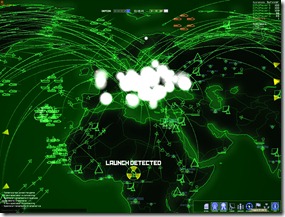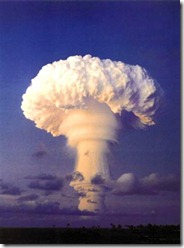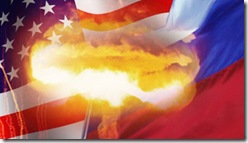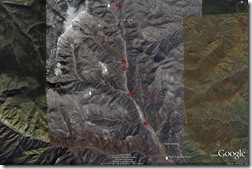Where the nukes are: 2009 edition

As the United States and Russia continue to consolidate their nuclear arsenals, the number of sites in the world that host nuclear weapons also has decreased.
The report is available here.
Perimeter, again
 Wired has a very interesting article on the Russian “dead hand” fail-safe command system for nuclear retaliation, called “Perimeter”. We have discussed this system before, but the article reveals some new and highly intriguing information about the nature and purpose of the “dead hand”:
Wired has a very interesting article on the Russian “dead hand” fail-safe command system for nuclear retaliation, called “Perimeter”. We have discussed this system before, but the article reveals some new and highly intriguing information about the nature and purpose of the “dead hand”:
According to both Yarynich and Zheleznyakov, Perimeter was never meant as a traditional doomsday machine. The Soviets had taken game theory one step further than Kubrick, Szilard, and everyone else: They built a system to deter themselves.
By guaranteeing that Moscow could hit back, Perimeter was actually designed to keep an overeager Soviet military or civilian leader from launching prematurely during a crisis. The point, Zheleznyakov says, was "to cool down all these hotheads and extremists. No matter what was going to happen, there still would be revenge. Those who attack us will be punished."
And Perimeter bought the Soviets time. After the US installed deadly accurate Pershing II missiles on German bases in December 1983, Kremlin military planners assumed they would have only 10 to 15 minutes from the moment radar picked up an attack until impact. Given the paranoia of the era, it is not unimaginable that a malfunctioning radar, a flock of geese that looked like an incoming warhead, or a misinterpreted American war exercise could have triggered a catastrophe. Indeed, all these events actually occurred at some point. If they had happened at the same time, Armageddon might have ensued.
Perimeter solved that problem. If Soviet radar picked up an ominous but ambiguous signal, the leaders could turn on Perimeter and wait. If it turned out to be geese, they could relax and Perimeter would stand down. Confirming actual detonations on Soviet soil is far easier than confirming distant launches. "That is why we have the system," Yarynich says. "To avoid a tragic mistake. "
Most definitely a must-read for anyone interested in nuclear matters.
Talking frankly about nukes
 Ares has a very interesting report on a recent symposium held by the US STRATCOM on matters of nuclear deterrence. The real value of the meeting was at the number of foreign experts involved, and the wide variety of doctrines and ideas expressed:
Ares has a very interesting report on a recent symposium held by the US STRATCOM on matters of nuclear deterrence. The real value of the meeting was at the number of foreign experts involved, and the wide variety of doctrines and ideas expressed:
With the understandable exceptions of Iran and Korea, every nuclear power in the world was represented at the symposium. Speakers and delegates included the Catholic archbishop of Baltimore and arms-control advocates, senior US and non-US officers (including the UK’s First Sea Lord, Adm Sir Mark Stanhope), and an array of nuclear scientists and engineers including the "retirement-flunking" Dr John Foster, who started his career in electronic warfare with the US Army Air Force in 1943. Russian ambassador Sergey Kislyak said it was "the only two-day sumposium where I never wanted to miss a single panel."
Major media covered the event heavily, if by major media you mean me, the Omaha World-Herald, the National Catholic Reporter and an arms-control website. But NBC nailed an interview with Michael Jackson’s chef on Thursday morning, so it’s all good.
Lots of very interesting doctrinal material in the report; a must-read.
Russia willing for deep strategic arms reduction
 According to this Washington Post article, Russia is willing to engage in drastic reductions in its strategic arsenal as part of a START-replacement treaty with the US:
According to this Washington Post article, Russia is willing to engage in drastic reductions in its strategic arsenal as part of a START-replacement treaty with the US:
"We are ready to reduce by several times the number of nuclear delivery vehicles compared with the START-1 pact," [President Medvedev] told a news conference in Amsterdam.
"As far as warheads are concerned, their numbers should be lower than envisaged by the Moscow 2002 pact," he added.
He was referring to an interim pact called the Strategic Offensive Reductions Treaty (SORT) which commits the sides to further cuts in their arsenals to between 1,700 and 2,200 warheads by 2012.
Naturally, this Russian direction must be judged in light of the inevitable shrinkage of Russian strategic nuclear forces in the forthcoming years, as existing delivery systems (particularly ICBMs and missile submarines) reach the end of their operational lives and their replacements are produced in insufficient quantities for a 1-on-1 swap.
IMINT & Analysis: Nuclear N.Korea
 SOC has published a detailed photographic analysis of North Korea’s nuclear infrastructure.
SOC has published a detailed photographic analysis of North Korea’s nuclear infrastructure.
Once again, the DPRK has become an area of focus for intelligence analysts and politicians as the next course of action for the West is determined. While it remains to be seen whether or not tensions between the DPRK, its southern neighbor, and the rest of the world will be mitigated, one fact remains: the DPRK is developing a nuclear arsenal.
As always, top-notch work by SOC; a highly recommended read.





